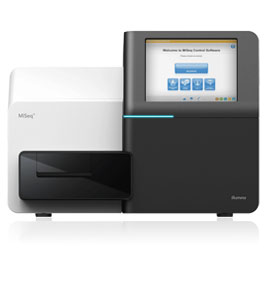
I was supposed to be going off to sleep after posting my latest on Ion Torrent but made the mistake of checking my RSS feed -- and there was a new item from Forbes' Matthew Herper (who, I was thrilled to find mentioning this space last week) about a new system from Illumina (announced this evening, hence I get to scoop GenomeWeb!). So much for a quick exit to bed (luckily, I'm working home tomorrow -- Boston area expecting a vicious winter storm).
The new system is called MiSeq and it is clearly a direct challenge to Ion Torrent as well as the 454 Jr. According to the press release, it will be priced around $125K with run costs in the $400-$750 range. What's really stunning are the specs: 6.8M 2x150 paired end reads in 27 hours -- including cluster generation!! That's really astounding! Plus it needs only 2 square feet of bench space for the entire setup.
Illumina's chemistry is well established, and (as I really appreciate having just done a SOLiD project) they really have the bulk of the academic informatics mind share as well. Paired end reads are really valuable in a number of contexts, or with short targets (e.g. PCR amplicons) they can be treated close to a single read of somewhere less than 300bp.
The time is also amazing compared to HiSeq, which is spec-ed at 8 days for 2x150 paired end reads. Now, some (all?) of this speedup could simply be through shortening the imaging time; since the flowcells for MiSeq are much smaller, the time to scan them could be similarly reduced. I don't know how much time per base cycle is in scanning vs. chemistry, but it seems like a lot of time could be saved. Alas, if this is the answer (as opposed to clever speeding up of the chemistry), then it doesn't translate to faster run times for HiSeq.
The only catch is the system is being announced now; actual machines won't ship until summer. My rough memory is that Illumina has been pretty good about hitting their product launch targets, so perhaps by end of summer I could try one out. It also certainly puts greater impetus on Ion Torrent to drive performance of their system. Illumina is claiming that sample-to-data time will be faster and about 2X the data of the new chip, plus paired end information. Ion Torrent's challenge areas could tip things back the other way -- halve the sample-to-data time, double the read length and double the accuracy.
Illumina also announced they are buying sample prep kit company Epicentre. Epicentre's amazingly clever transposon-based library prep system was one ingredient in a recent whole-genome haplotyping paper (which I was supposed to write on by now; gotta get that done!). They've also demonstrated the ability of this approach to build libraries from amazingly small input amounts. It's a natural buy for Illumina (Epicentre also makes kits for mRNA and miRNA preparation), but it's also a bit bittersweet to see it happen as this means these technologies won't be available (or at least won't be developed as energetically) for other platforms. Of course, if newer platforms can use libraries designed for Illumina, that issue won't apply (as I've noted before).
6 comments:
The MiSeq will be favored by clinics for the ease and speed of sample prep. With a set of pipets and a thermocycler, you only need to take unsheared DNA through the Nextera step to PCR enrichment, then onto the MiSeq. Even if the Ion PGM speeds up sequencing, the time and equipment needed for emPCR is so highly unfavorable, it is not ever clinically relevant. If Ion could get rid of the bead, they might have something that scales.
I suppose my question is this: Are there any tasks for which you would see a PGM being useful where a MiSeq would not?
Hi Keith,
I really enjoy your analyses of the sequencing platforms! But I'm afraid you did not scoop GenomeWeb on this :-) . We had a story on MiSeq up at 7.28 pm ET on Wednesday:
http://www.genomeweb.com/sequencing/illuminas-low-cost-miseq-promises-speed-next-gen-sequencing
Alas, Julie is clearly right - I will have to work much harder to break a story ahead of In Sequence.
@Matthew The PGM would be useful for experiments that you want to run between now and this summer as the MiSeq doesn't really exist yet. Also, even though it generates less data, the short 2 hour run of the PGM will be pretty attractive. Of course, that's not counting the really long/ugly sample prep.
The main problem with MiSeq is that most of the first batch has been allocated to the US, only a few will go to Europe so it's a bit like whoever gets there first. Some scandinavian labs bought a couple, Germany and the UK as well. But Italy, France and Spain are, as usual, behind everyone.
Post a Comment